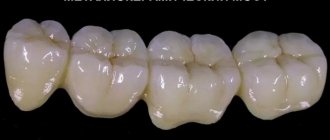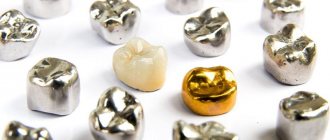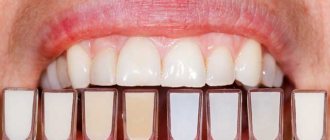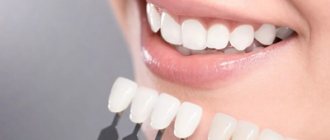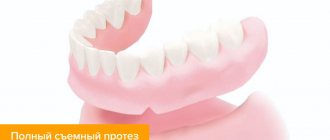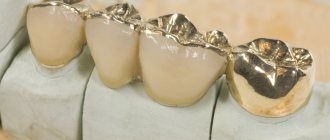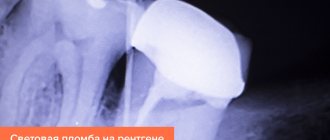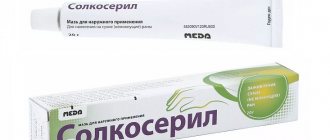In this article, we will consider situations when a filling can be installed on a tooth, and in which cases it is better to give preference to a ceramic tooth inlay.
Caries is the most common dental disease for which people go to the dentist. It is ideal if it is possible to identify caries at the earliest stage of its development. But this is not always possible for various reasons. Caries occurs not only on a tooth that has not been treated, but secondary caries can also develop under a previously installed filling. Sometimes this destructive process develops so secretly that it is simply impossible to visually determine it yourself. Meanwhile, tooth tissues are affected more and more over time. In order to prevent such development of the disease, it is necessary to regularly use dental services for preventive examinations once every six months. A specialist during an examination will always be able to identify the presence of a disease using a visual examination and various modern methods of x-ray diagnostics.
The classic restoration of a tooth after treatment is the placement of a filling in a prepared cavity. But this method is good if there is a small cavity. When most of the tooth is destroyed, it is better to restore such a tooth with a ceramic inlay.
The main difference between a dental inlay and a filling
Dentistry, as the most technology-related branch of medicine, is developing by leaps and bounds. New materials and treatment technologies appear here with enviable regularity, and one of them is the manufacture and installation of inlays. What are dental inlays? These are high-precision parts made of ceramic or composite material that fit very tightly to the tissues of the prepared tooth. Dental inlays are made in laboratories by dental technicians, rather than being performed directly in the patient's mouth, as was the case with fillings.
This type of work, on the one hand, prolongs the treatment itself, because this will require the patient to make two visits:
- for tooth preparation and impression taking;
- to install the manufactured tab.
Between these events, the dental technician works on making the inlay. As a basis, he takes an impression obtained from a ground area in the tooth. This is called the direct tab creation method. There is also an indirect method, where not only a cast is taken as a basis, but also a photograph of the jaws, which helps to understand what the chewing surface of the tooth should be like. It depends on occlusion, that is, the overlap of the jaws when closed. In the second case, the cost of producing one tab is higher, but the accuracy is also higher.
What is a filling?
A filling is the restoration of a tooth defect formed after treatment of caries or other tooth damage using filling materials.
In dentistry, there are many filling materials that can replace such defects. Today, the most practical to use are photocomposites (light-curing filling materials). Despite their advantages, fillings also have disadvantages that significantly reduce the lifespan of a tooth:
- shrinkage during light curing,
- chipping of the thin walls of the filling,
- instability to external influences - darken over time, color changes due to exposure to tobacco, coffee and other dyes.
Guided by these shortcomings, the use of fillings in case of large damage is inappropriate. In such situations, the most optimal solution would be to use tabs.
Types of dental inlays
The types of dental inlays also differ, depending on the degree of tooth decay. This can be either a simple inlay or an inlay for a crown. Such an element is made of metal, because it will not be visible later. A dental inlay for a crown can save a tooth even when all that remains is an unsightly root and no visible part. Due to this, it is as if the tooth is growing, onto which you can then put a well-fitted crown made of ceramics or metal-ceramics. Dental inlays for a crown themselves are inexpensive; the main cost of treatment is the price of the crown.
Pros and cons of tabs
Ceramic inlays have a number of advantages compared to other methods of restoring teeth. The advantages of a ceramic tooth inlay include:
Veneers on teeth: pros and cons
- the ability to mask large cavities and destroyed fragments;
- no need to adjust the size of the product due to its exact fit (seals do not meet these criteria);
- no staining from food or changes in original external characteristics;
- minimal risk of developing allergic reactions due to the high biocompatibility of the materials of the inlay and the oral mucosa;
- stability and strength, which makes it possible to consume familiar food products, including hard ones (nuts, seeds, crackers);
- no discomfort during operation.
Inlays also have a number of disadvantages, among which patients highlight:
- long recovery period after the procedure;
- the need to wait for the production of products;
- high cost of restoration;
- the need for several visits to the clinic.
How much do dental inlays cost?
Surprisingly, the cost of dental inlays varies greatly, even ranging from 2,000 to 50,000 rubles. This depends on the method and material used in the manufacture and installation of the tab. The most expensive option is a zirconium dioxide inlay made by the indirect method, as well as an inlay for the crown plus the crown itself.
The cheapest type is a small insert into a prepared carious cavity, made of composite material or metal.
If you translate the cost of work and inlays into service life, then it may also turn out to be cheaper than a filling, since you won’t have to change it often.
Filling or...? About choosing a method of tooth restoration.
Quite often in my practice, when discussing a method of tooth restoration with a patient, I hear the question: “Doctor, why not a filling?!” In my article I will try to briefly describe the pros and cons of several methods of tooth restoration. So let's get started.
Filling or...?
The main component of tooth longevity is the integrity of its tissues. Based on this, any treatment should be aimed at maximizing the preservation of intact tooth tissue at the time of restoration and for years after. And here the next problem arises - the choice of restoration material. Let's look at the clear pros and cons:
Advantages of ceramics:
1) Durability
2) giving shape outside the oral cavity - allows for a more correct comparison of the restoration with the opposite and neighboring teeth
3) Very smooth surface - (less plaque)
4) Durability
Minuses:
1) Price (work of two specialists in the case of ceramics)
2) The need for several visits
It is not difficult to understand that the pros and cons of ceramics and composites are polar.
When comparing a regular filling and a ceramic filling, I like to give the example of circles. Compare two white mugs - plastic and porcelain. Drink coffee from both throughout the year. I think you won’t want to pick up a plastic mug – it will be covered in residue. And since a dental composite is essentially plastic, albeit somewhat strengthened, then with “fillings” it’s like with circles.
Not very presentable, is it?
What are the indications for ceramic inlay fillings:
1) Large carious cavities exceeding 50 percent of the tooth area
2) Cavities that run from front to back (longitudinally across the entire tooth)
3) Chipping/missing one or more tooth cusps
4) A tooth “without a nerve”, a pulpless tooth. In this case, we can talk about a crown.
Indications for simple composite fillings:
1) Small tooth defects (less than 50% of the area)
“You're going to cut my tooth off!” »
Another persistent fear of patients and, unfortunately, of many doctors (though it concerns crowns more, but still) is the fear of over-preparation. I can assure you that a qualified doctor who uses magnification in his work will not remove too much, but will only remove those places that have a high risk of breaking. For some reason, many people forget that in order to place a “filling” the tooth also needs to be prepared (often no less than for an inlay), but for some reason the “filling” is still not so painful for patients. More familiar, perhaps. “It fell out - I’ll put a new one in.” But every time he places a new filling, the doctor is forced to re-excise the tooth. At the beginning of the article, I said that the main thing is to keep the structure of the teeth intact for a long period of time - it will be possible to replace the fillings that fall out every 2-3 years a couple of times. Then - depulpation and again a filling (more and more), then - tooth fracture - and removal. Or not. If we get lucky. Russian roulette, no less.
“But my neighbor/friend/grandmother has it for 20 years!”
... and everything would be fine, but each person has an individual clinical case, since we are all different. The tooth experiences very significant loads, and in each mouth it is different. Some people only eat salads, while others don’t mind trying a steak with veins (and bones). And if the tooth is weakened, sooner or later the following trouble happens:
The goal of any treatment is a minimum of complications. And if the tooth from the photo above was successfully restored (since the chip does not go deep under the gum), then often everything can end like this:
Do you want to take a risk and limit yourself to a “filling” where the ceramic inlay is shown? It is always your right and your choice. The main thing is that it is thoughtful.
Now I’ll give you a few examples from my practice.
Here, an aesthetic restoration of the first maxillary molar on the right was performed. The tooth tissue is preserved as much as possible, why not opt for a “filling”, or rather an artistic composite restoration? In this case, this is the most appropriate method for eliminating a carious defect.
Next example.
“Fillings” with signs of caries around were replaced with aesthetic restorations made of composite material. Of course, for the purpose of greater durability, it would be possible to use a ceramic restoration, but from the point of view of function (breaking off walls, chipping), the tooth is not in danger.
But here are examples from another “opera”.
Extensive composite restorations are visible on teeth 4.6 and 4.7. In this case, it was necessary to resort to indirect ceramic restorations, since the area of destruction of the coronal part was significant, in addition, the nearest tooth (4.6) was depulped.
The intraoral photograph shows only the transition of color from the restoration to the tooth tissue (if everything is done correctly), no joints or nicks.
Here is the following example, when an indirect tooth restoration was performed with a ceramic inlay. The patient came with complaints about a chipped piece of the “filling”:
As you can see in the photographs, part of the tooth cusp broke off, not the filling. Cracks in the enamel on the side surface of the tooth and secondary caries on the contact surface (between the teeth) are clearly visible. Taking into account the objective picture, it was decided to make a ceramic restoration, which was fixed in the oral cavity according to a modern protocol:
I would like to specifically mention this slide:
On it, the color transition is hardly visible, not to mention the “gap” or “seam” of the restoration.
In my article, I did not set out to cover all the nuances and subtleties of microprosthetics and filling defects with a composite; it is difficult to do this within the confines of one article - this is the topic of an entire lecture. However, a couple of examples will not hurt anyone. I hope that they will help patients make the right choices a little more confidently than they currently are.
Of course, ceramic restorations are more expensive. Beauty and durability come at a price.
In conclusion, I would like to wish all those who have doubts to find a doctor whom you will believe and trust, who is truly passionate about his work. Good luck to everyone!
Author of the article and clinical cases: dentist Pavel Pola
Installation technique
Reconstruction of row elements using ceramic inlays occurs in stages:
- First, old fillings (if any) are removed. Teeth preparation occurs using a cooling system that prevents overheating of bone tissue. Grinding of the restored unit often occurs with the use of magnifying dental instruments (binocular glasses). Thanks to them, the doctor will be able to preserve a larger volume of healthy dentin tissue.
- After preparation, the resulting cavity is processed with a caries detector. The method allows you to identify the affected areas remaining after preparation.
- Precision grinding and smoothing of tooth edges with Arkansas stone. The steps of the procedure are necessary to ensure a good fit of the ceramic inlay.
- After this, an impression is taken from the problem unit, from which the dental technician will create an inlay. Checking the compliance of the parameters of the inlay with the resulting cavity is also carried out using binocular glasses.
At the last stage, the manufactured product is attached to the tooth. Various adhesives are used for this purpose. After installation of the structures, the patient will need to adhere to a number of rules in order to extend the life of the inlays.
Private clinics practice a new method of dental restoration using the Chairside technique, which allows you to restore the aesthetics of your smile in one visit to the dentist.
During the procedure, the dentist uses a device equipped with a three-dimensional camera. Powder is applied to the work area before taking the photo. This makes the image more accurate and clear. The 3D device transmits the resulting image to a large screen and uses it to calculate the parameters of the future tab. All data is transmitted to the grinding unit, which grinds the product. The procedure takes no more than 30 minutes.
Establishment technology
High-quality production of modern inserts requires a detailed study of the casts made. The specialist enters all the necessary information into the computer program. It displays pictures and diagrams of the future design. With the help of an electronic program, even minor defects and deviations are eliminated, a shade is selected that is more consistent with the natural healthy units of a particular patient.
Installation of orthodontic ceramic products is possible only on the root organ. Of course, before installing the structure, you need to take into account contraindications. The products are not used for baby teeth, since their service life is short, unlike a ceramic device. Also, the system is placed only on a solid foundation. If the destruction exceeds 60%, the optimal prosthesis option is a crown. After all, in order to fully install the tabs, you definitely need two walls. If caries is present, therapy is first carried out. Treatment of caries in St. Petersburg is carried out in almost every clinic. Choose among them the one that meets modern requirements.
Possibility of complications and subsequent care
As a result of preparing the desired cavity shape, secondary caries or pulpitis may develop. Those patients who suffer from unit sensitivity are at risk of discomfort. Also, opening the cavity sometimes leads to the insert falling out. Only a doctor can correct the situation. After installing the product, follow the recommendations given by the specialist. It's about careful and regular hygiene. Cleaning takes 2-3 minutes. You should rinse your mouth after every meal. Do not subject your teeth to excessive mechanical stress.
The type of microprostheses considered is the most common today. With it, the dentition always looks aesthetically pleasing, and the patient does not suffer from discomfort, as often happens after filling.
When is the best time to choose a ceramic inlay?
Everyone is familiar with the method of restoring the crown of a tooth by filling it with a composite material. In this case, it fills the entire cleaned carious cavity of the tooth layer by layer. However, with a large volume of damage, when the size of the cavity becomes significant, the doctor does not undertake such a procedure. Given these clinical conditions, there is a risk that, due to even slight shrinkage of the material, it is difficult to prevent chipping of the tooth wall.
If it is necessary to restore large areas of a tooth, experts consider using a ceramic inlay instead of a filling as the best solution. This will provide not only a long-lasting result, allowing you to significantly extend the life of the tooth, but also fully guarantees its aesthetic impeccability.
How is ceramic used for inlays?
A technology called CEREC may provide the answer. It is responsible for the high precision of the manufactured structure.
Stages of installing tabs.
- The dentist gets rid of all dental areas damaged by caries and, if necessary, removes the old filling.
- The diseased tooth is scanned using an intraoral device.
- A real model of the tab is created on the computer.
- The ceramic blank is sent for grinding, where, taking into account the created model, the inlay is reproduced with almost 100% accuracy. This is an important step, since high precision allows you to get an inlay that perfectly matches the tooth and enamel.
- Installing the tab and fixing it. Digital technologies have made it possible to forget about crowns and save the tooth from destruction or extraction and develop a design that is distinguished by its strength, durability and compatibility with teeth.
